2023-2024 Nidecker Supermatic Snowboard Binding
Size Range:
- Medium: 4.5–8.5 US Men’s / Mondo 23.0–26.0
- Large: 8–11.5 US Men’s / Mondo 26.0–28.5
- Extra Large: 11–13 US Men’s / Mondo 29.0–31.0
Stated Flex: 8/10 (torsional and longitudinal)
Blister’s Measured Weight per Binding (size Large): 1251 & 1265 g / 2.76 & 2.79lbs
Stated Features:
- Automatic Dual Entry
- Nylon/Glass Asymmetric Baseplates
- Asymmetric Highbacks w/ forward lean adjustment
- Nylon Mutlidisk (4hp+3hp+channel)
- 2.5° canted footbeds
- Locking Slap Ratchet buckles
- Hexo and Exo 3D strap patterns
MSRP $399.95
Reviewer: 5’10”, 170 lbs / 178 cm, 77.27 kg
Test Locations: Crested Butte Mountain Resort, CO; Taos Ski Valley, NM
Test Duration: 50+ days
[Note: Our review was conducted on the 22/23 Supermatic, which returned unchanged for 23/24, apart from colors.]
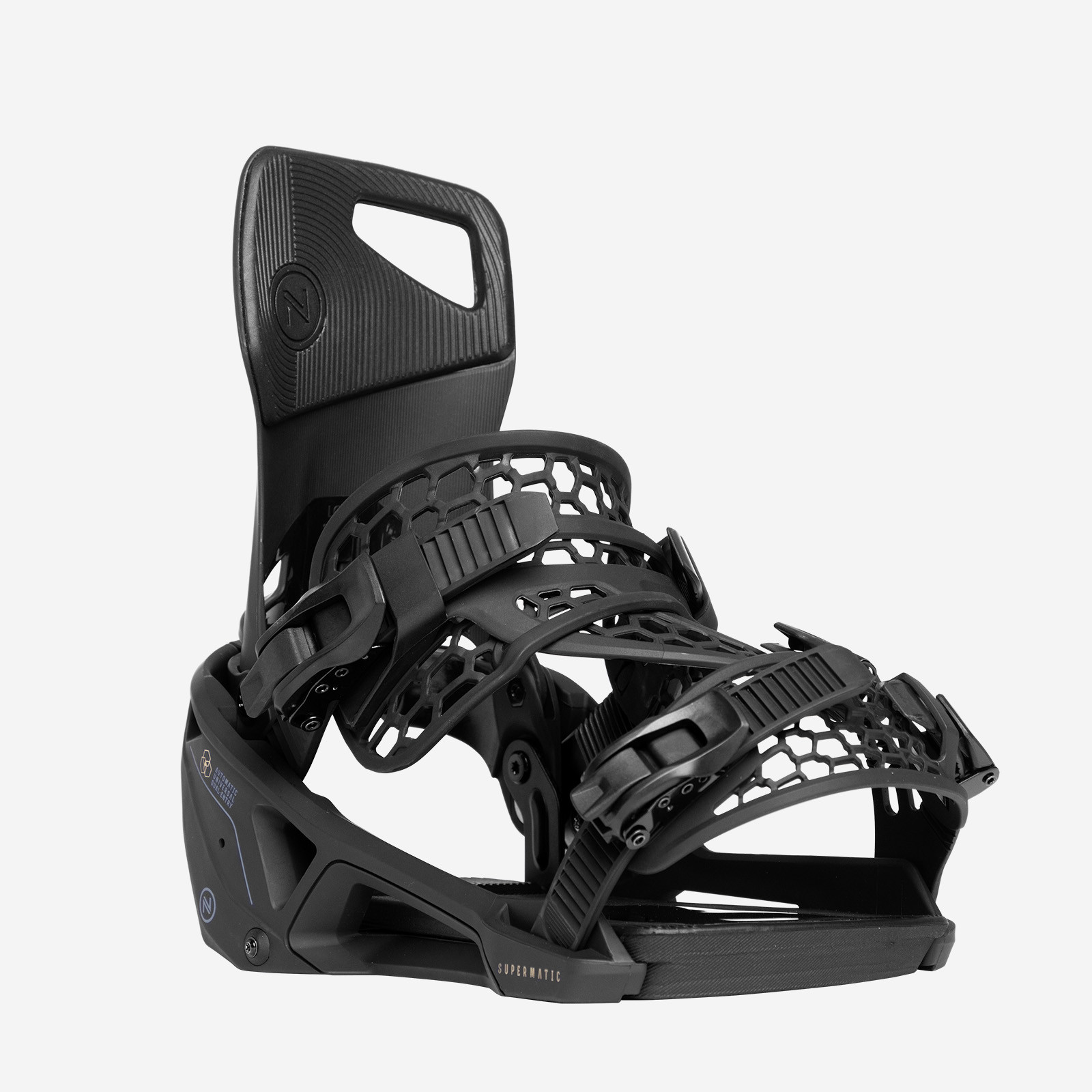
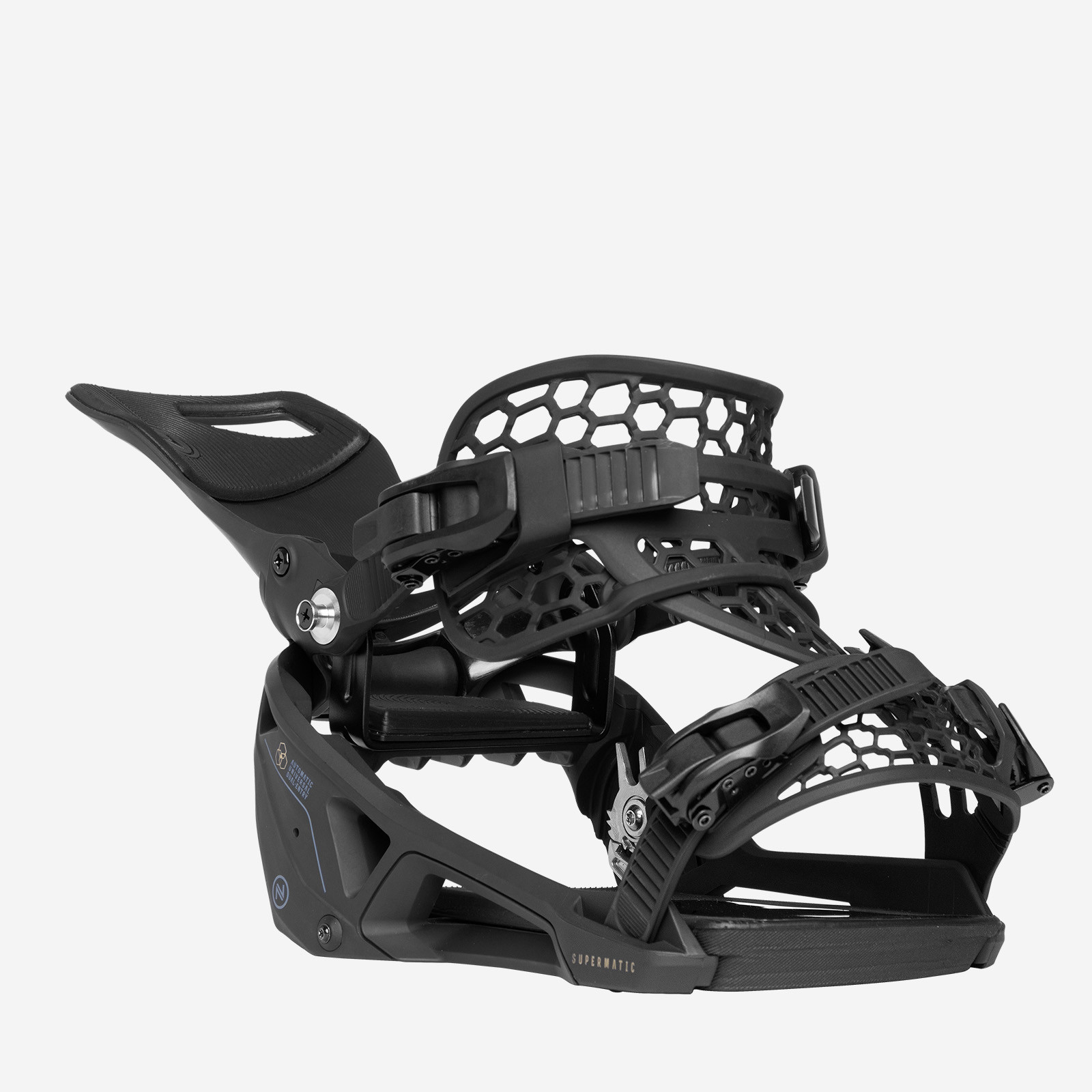

Intro
For decades, various brands and individuals have been trying to come up with snowboard bindings that are quicker and easier when it comes to getting into and out of them.
One of the latest additions to this category is the Nidecker Supermatic, a dual-entry “automatic” snowboard binding that allows the rider to “step in” to the binding, rather than having to completely loosen and tighten the straps for each run. Released in 2022 and returning for the 23/24 season with new colors, the Supermatic takes a unique approach to a concept that has been tried by many companies but seems to have been slow on the uptake due to various compromises inherent to past designs.
Some of the primary limitations with previous “step in” options were the lack of boot options due to the bindings requiring specific boots, and/or performance shortcomings relative to traditional options. The Supermatic aims to address those downsides by offering a “step in” style of entry while also (reportedly) being compatible with any boot on the market and functioning pretty similarly to a regular binding once locked into downhill mode.
As someone who has used a variety of “drop-back” bindings from Flow and K2, in addition to plenty of traditional bindings, I found the Supermatic very intriguing. Last season, I got to put that curiosity to the test, running the Supermatic as my primary binding for most of the season.
Here, we’ll get into how the Supermatic functions, how it compares to a variety of other binding designs, and the sorts of riders for which this binding makes the most sense.
What Nidecker Says About The Supermatic
“The Nidecker Supermatic is what snowboarding has been waiting for: the first universal, dual-entry, automatic binding. Many brands have tried and failed to crack the step-in code. Most of these systems required specific boots; many didn’t work well in powder; and none of them were as comfortable and reliable as a regular two-strap binding. We’ve spent four years developing our own solution that addresses all these issues, and it’s a genuine game changer.”
Sizing and Adjustability
We have been testing the size Large version of the Supermatic, to pair with my US Men’s size 9.0 K2 Thraxis boots. For reference, Nidecker recommends a size Medium Supermatic for boot sizes 4.5–8.5; the Large is recommended for sizes 8–11.5. I.e., my boots are right on the cusp of being too small for the size Large.
With my boots, the interface between the boots and bindings does seem to have a fair amount of room between the heel cup and edges of the baseplate. This had me wondering if Nidecker’s sizing recommendation is appropriate; I’m guessing the extra room may be related to the spacing requirements for the “automatic” rear entry. Despite space existing between the boot and the baseplate, the Supermatic did seem to encompass my foot well enough to not slip into the open space. I have not been able to try a size Medium Supermatic with my size 9 K2 Thraxis boots, but those boots are on the smaller end of the spectrum in terms of overall volume. I was able to spend a few days in the Supermatic with my size 9 K2 Orton boots, which are a bit higher in volume and they seem to fit more tightly into the baseplate. Once I had the Supermatic fully tightened down, I did not notice a performance discrepancy as a result of the fit, but if you’re like me and your boots are on the fence between binding sizes, I’d recommend trying on both sizes, if possible.
Overall, the Supermatic’s strapping system distributes forces well across the foot and keeps everything tight and in place. The adjustability of the Supermatics is pretty limited and another reason why I thought they seemed sized on the larger side. There is no way to adjust the heel cup, strap locations, or toe-ramp distances, features found on many other bindings. This is partially due to boot volumes becoming more even across different boot brands, and possibly due to maintaining tight performance tolerances by reducing more points of flex. The Supermatic is also on the heavier end, and adding more adjustability may simply add unnecessary weight. But again, if you’re unsure about boot compatibility, trying on the Supermatic will be your best bet.
Entry / Exit Process
The Supermatic offers the ability to quickly step into the binding, but it also retains the ability to be used as a regular “strap-in/slap-out” binding.
Here’s a brief summary of the Supermatic’s “automatic” entry process:
When you release the Supermatic’s latch (located on the inside of the feet, near the base of the binding), its highback drops rearward and pushes the straps up and “open,” creating more space in which to slide the boot. You’d then slide your boot into the binding (guided by a roller) and eventually catch the “pedal” attached to the highback. When you step down on that pedal, the highback snaps into position and the straps return to their tightened position.
If you’re more of a visual learner, here’s a video from Nidecker about the Supermatic:
The opening of the space when the Supermatic’s highback is dropped is significantly broader than what I’ve previously found on Flow bindings such as the NX2, which compromised the convenience of the drop-back option a bit since I still had to adjust the ratchet location each time in order to make space for entry.
The Supermatic’s system offers enough movement / range of motion to reduce the need to tighten up a few clicks after stepping in, but I still had to do some extra tightening to get the Supermatic to feel tight enough for my preferences and similar to other bindings. Generally, this meant 4-5 extra clicks. As with other drop-back bindings I’ve used, I always had to loosen and retighten to get them snug enough for most of the riding conditions. However, the Supermatic required less of this fine-tuning than the K2 Cinch or Flow NX2 bindings, and I didn’t have to loosen the Supermatic’s straps in order to step out of them.
The Supermatic’s baseplate pad has a smooth toe piece designed to aid in entry by reducing friction when sliding the boot into position. And in general, I’d say the Supermatic offers great suspension and lots of cushion. It’s still a very responsive binding, thanks to the power transmission of its thick baseplate materials; the Supermatic tended to make a given board feel a little stiffer than it would with a binding that features a more minimal base design, such as something from NOW.

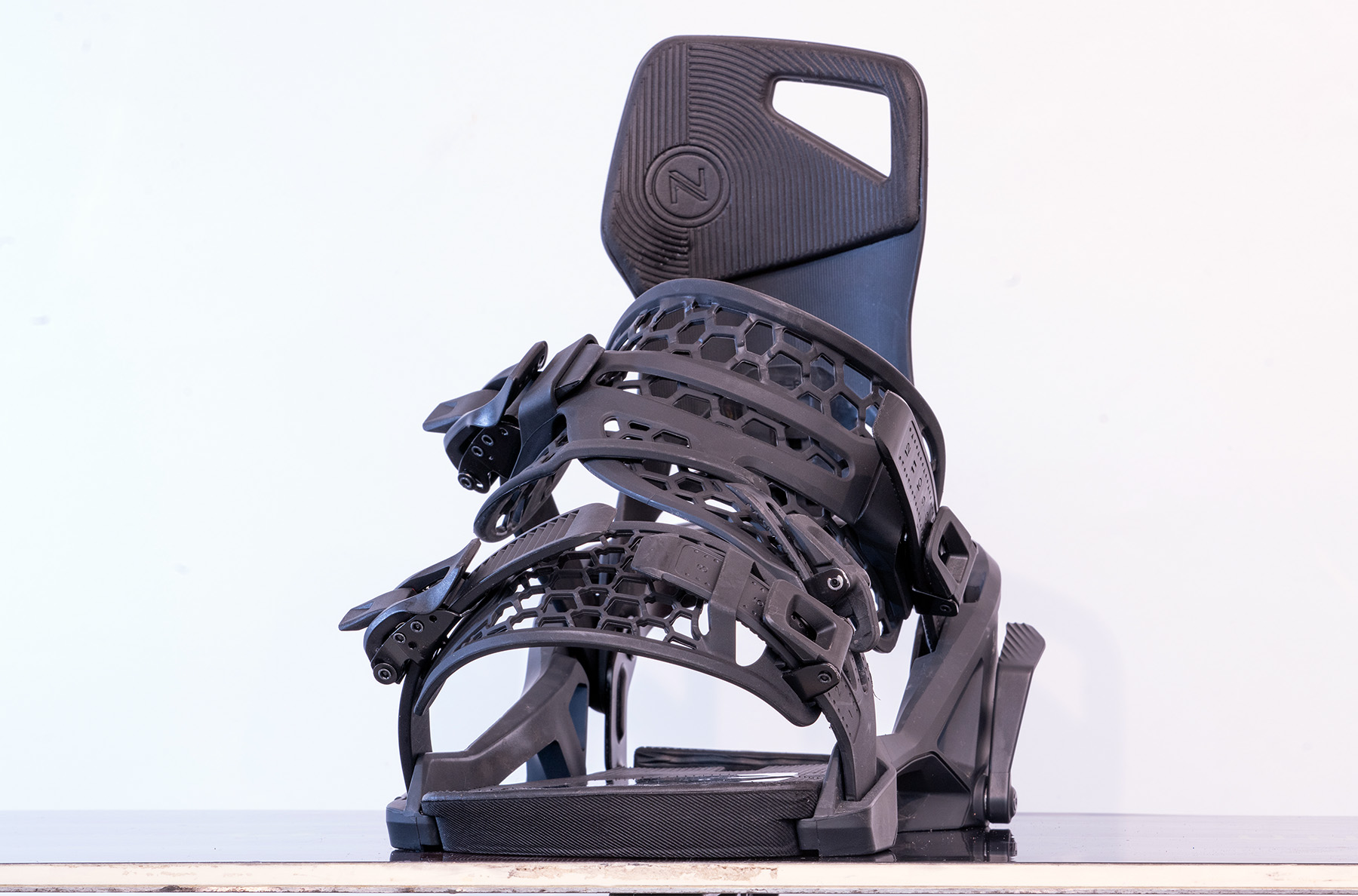

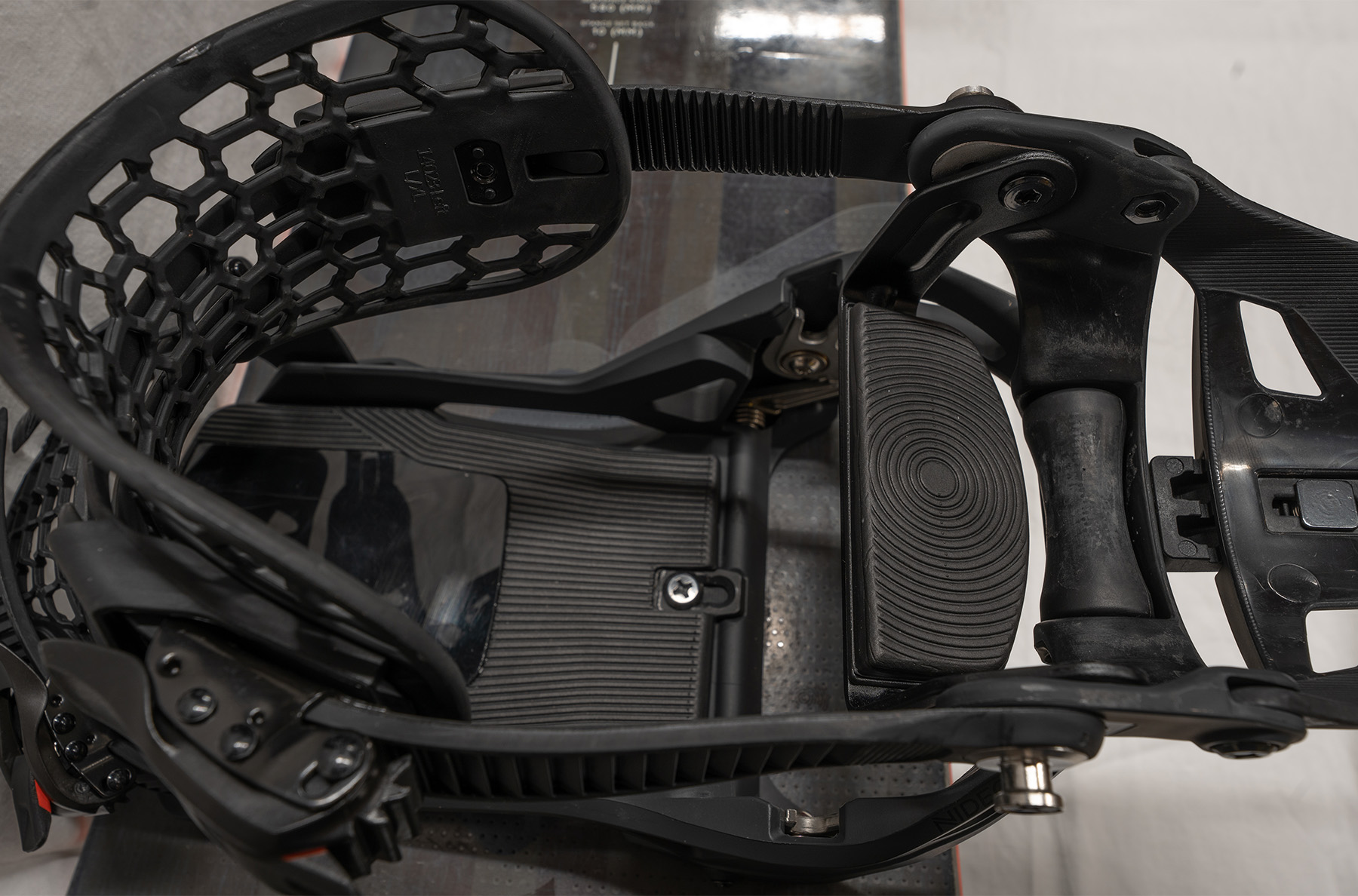
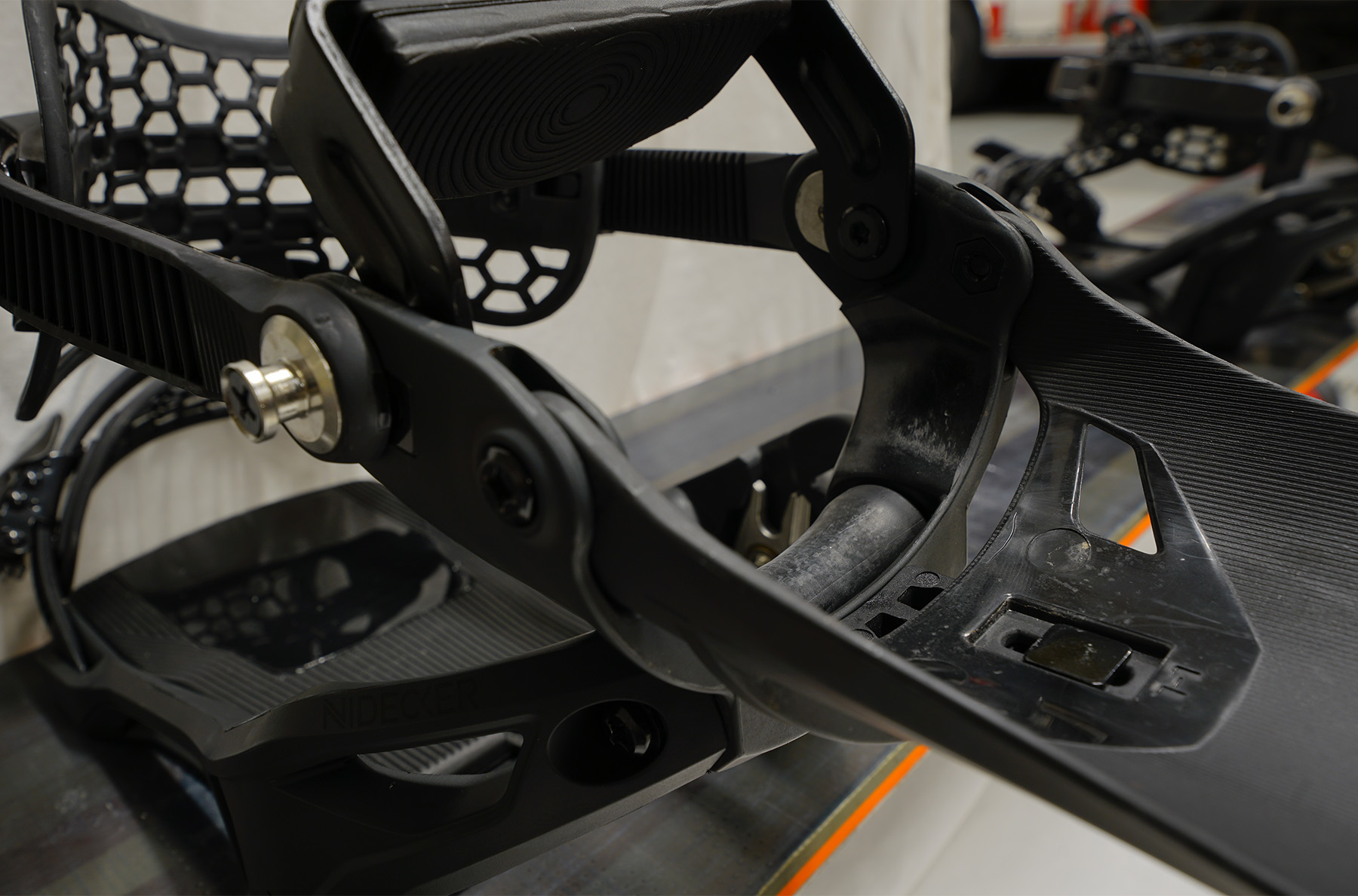
Latching Mechanism and Release
Another common worry associated with “automatic” or “step in” snowboard bindings is related to durability, since they feature more moving parts than traditional bindings. Overall, I’d say the Supermatic is well built and its latching mechanism does seem to have smooth operation while engaging. After a year of use, the metal components show very minimal wear.
The Supermatic’s highback is connected with two metal pins that mate with the receiving end of the latch. When these engage the latch, the heel cradle is depressed and the knobs trigger a succession of “clicks” that lock the binding into place. Once locked, the latch is trapped by the teeth through spring tension and friction.
This is a clever design and seems like a huge improvement over the previous versions of dual-entry bindings that used a cable on a lever on the back of the binding to create tension on the highback.
Very rarely did I have snow-buildup issues or weather-related problems when it came time to latch / unlatch the Supermatic. That said, I still like to make sure the area under the heel pedal is clear of snow. The binding will likely still click and latch if there’s a bit of snow in the way, but there’s a chance that packed-in snow could prevent the heel from locking down fully. Always important to make sure the binding is locked.
My most notable durability issue with this system last year occurred while I was skating along and managed to strike the Supermatic’s lowered highback on a tree. This impact pulled the “pin” part out of the heel cup.
I was able to bend and flex it back into position, but doing so took some time and substantial force (but no tools). Still, I would rather have had this happen than something break entirely; I suspect that the impact that bent the Supermatic’s pin would have snapped the highback of some traditional bindings.
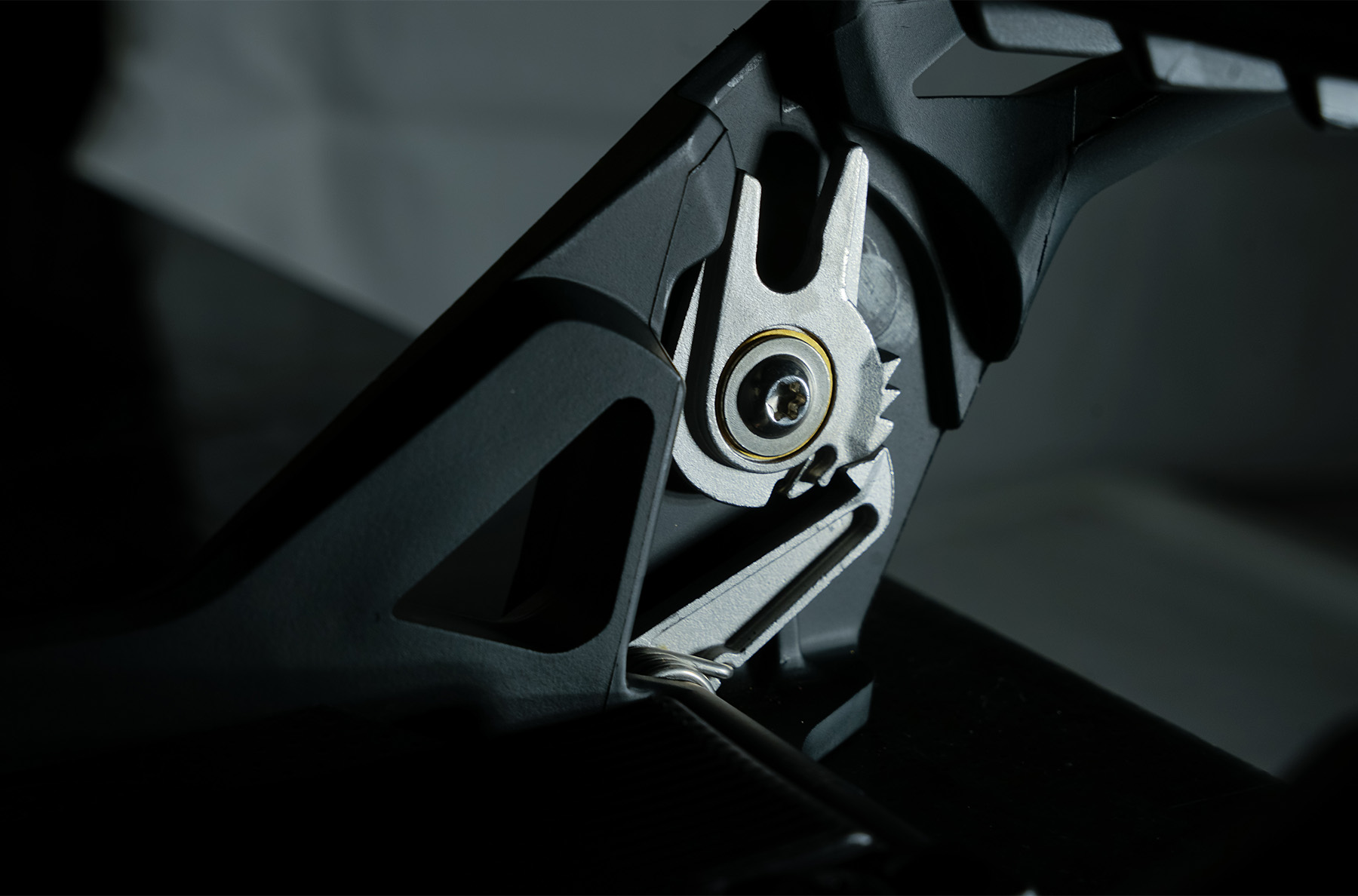

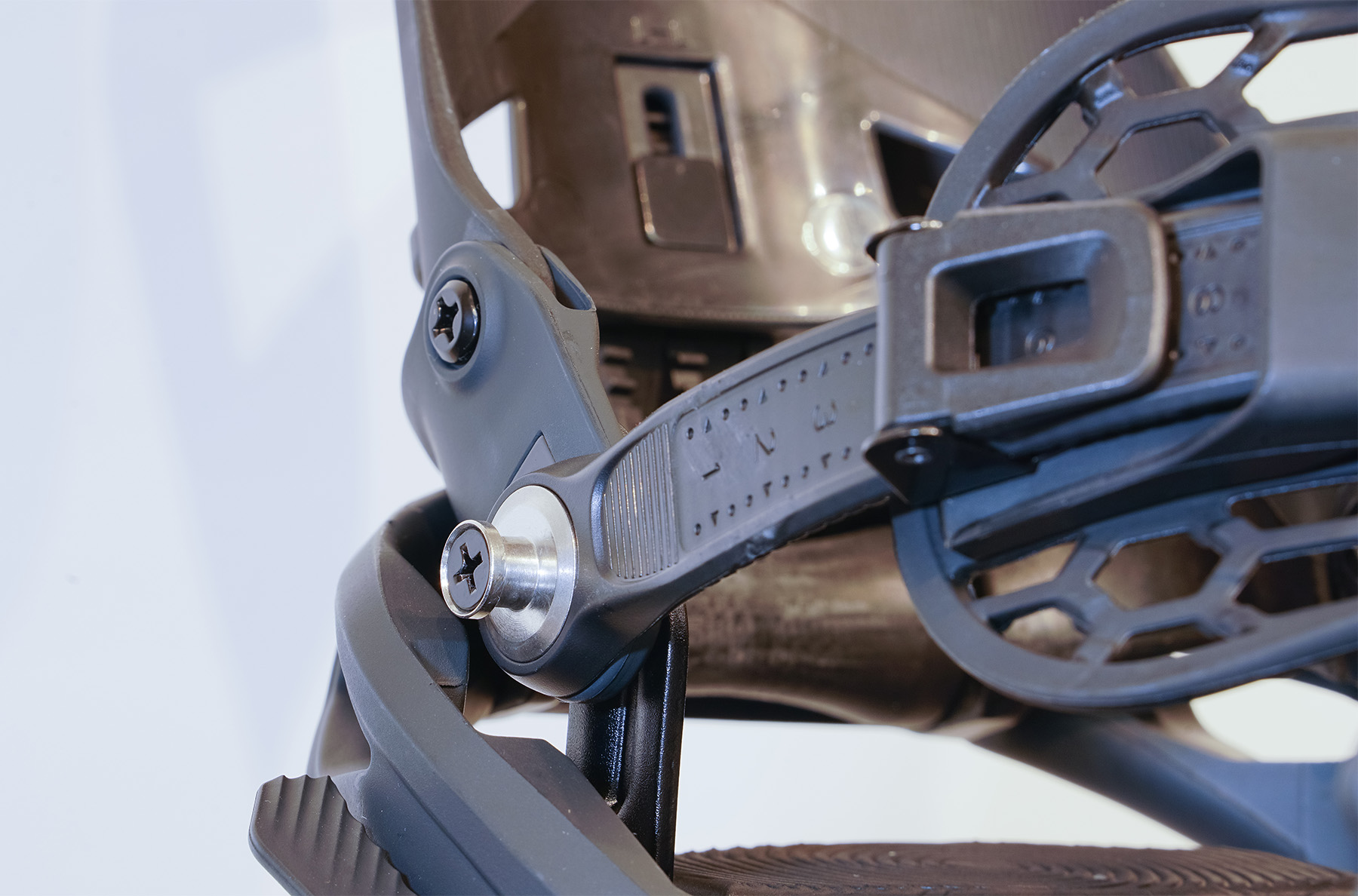
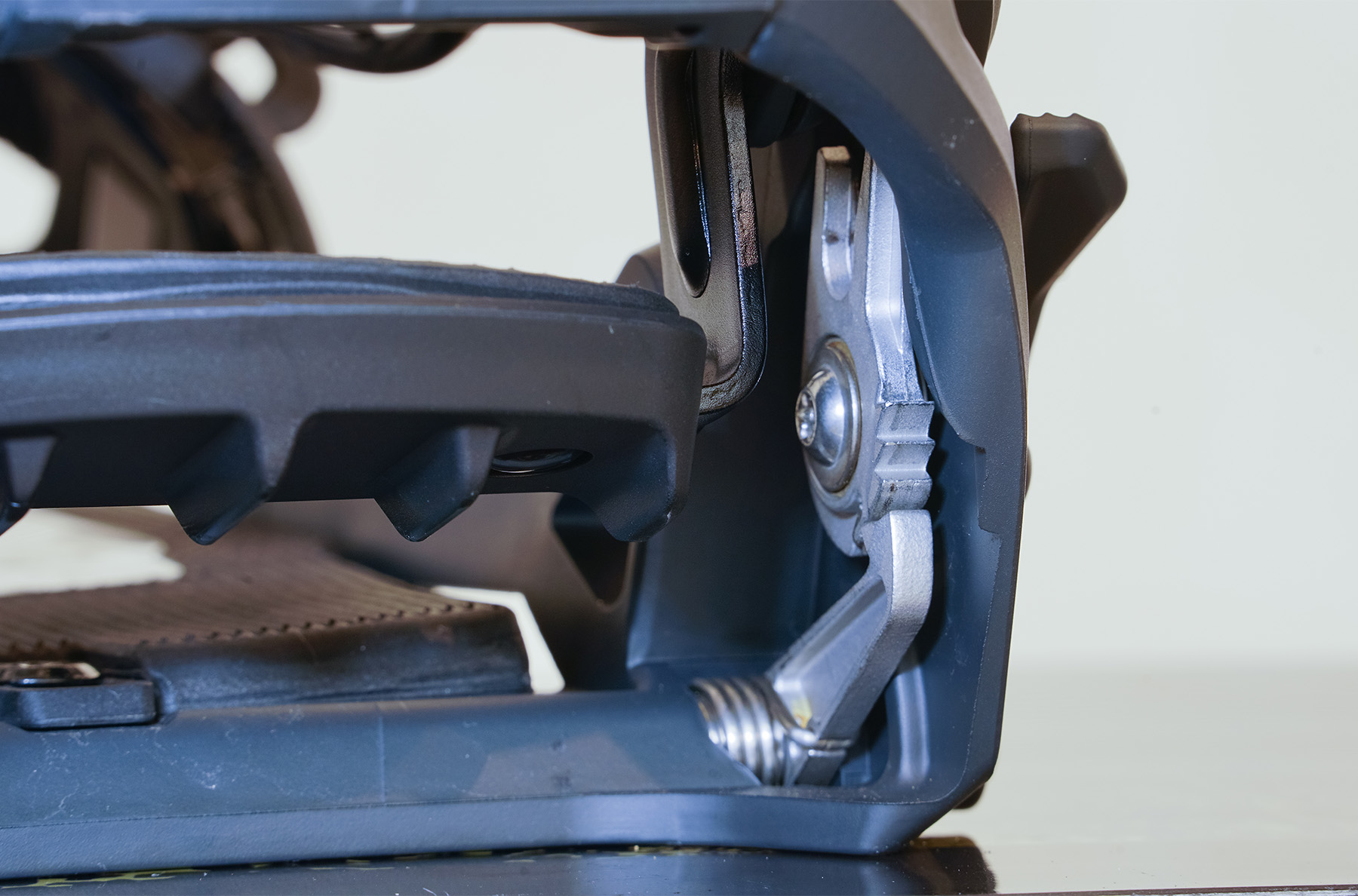
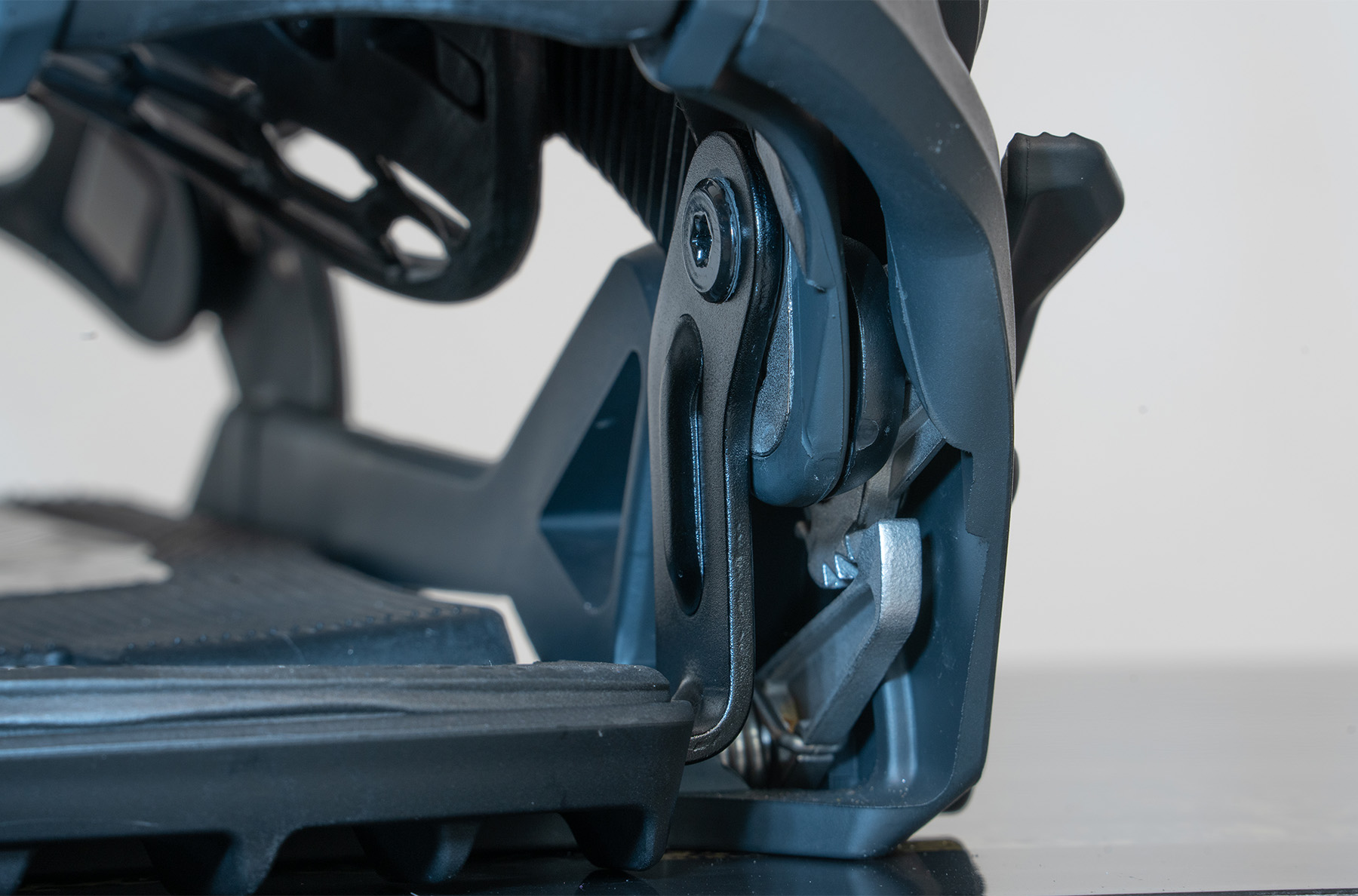
The Supermatic’s release lever, when depressed, lowers the latch and allows for the cam teeth to be freed. The position of the lever seems out of the way enough to hopefully not have an accidental release and it seems strong enough to withstand an accidental push without releasing. The multiple steps / teeth used for complete locking should also reduce the chances of accidental releases; it’s never accidentally released on me, and I suspect that would be quite rare.
The position of the Supermatic’s release is near the heel cup and sits between the rider’s legs. I found the location and action of the release to be more difficult than originally expected. I would say the release was easier to operate than the former drop-back versions that have a lever on the highback, but for me (not being that flexible), it was still a bit difficult to reach. The lever also requires a constant press to release fully, taking 2-3 seconds to hold and pull out your foot.
I used the Supermatic for most of the 22/23 season and at the end of the season, the heel portion of my boot started to separate. The boots were new at the start of the season and I’m guessing that, despite the roller on the Supermatic’s heel cup, increased force and friction were applied to the boot over and over again while releasing, to the point that it wore down the boot more quickly than a traditional binding.
I will be using the Supermatic with other boots during the 23/24 season and am curious to see if this boot sole damage occurs with other models. The wear was mostly on the back foot, due to the frequency of entry / exit, but the front foot also suffered some separation. Once the boot started to delaminate, its heel would get stuck and the automatic release was inconsistent, forcing me to “unstrap.”
Straps / Comfort
The Supermatic’s straps offer quite a bit of adjustability as far as strap balance is concerned and seem to sit higher across the foot than average, adding a more uniformly snug feel while reducing pressure across the ankle bend areas. The buckles lock, and when the middle tab is opened, they operate like a normal ratchet buckle. The Supermatic comes with directions for how to adjust it to your particular boots. I’ve found these instructions to fall a little short of reality (or at least, my preferences). I had to adjust beyond what Nidecker recommends to fit my boot, typically tightening an additional 4-5 clicks after I had stepped into the binding.
The Supermatic’s straps feel durable yet soft enough to effectively contour around my boots. I do tend to like strapping systems that disperse forces across a greater area, so I appreciate the Supermatic in this regard.

The overall design of Supermatic is quite clean, especially given their step-in system, meaning there aren’t a lot of exposed or unnecessary screws (this also ties into their lack of substantial adjustability). The Supermatic does include tooless adjustment options in a couple areas, like the strap position over the foot. Its asymmetric highbacks didn’t create any harsh pressure points for me and they had great coverage on my boot, which translates to a more responsive feel.
Once I had appropriately set and centered the straps over my feet, I was able to ride long days in the Supermatic without a ton of foot fatigue. There were some small pressure points that were noticeable when I cranked down really hard, but mostly, the bindings felt well balanced and very secure.
Performance / Stiffness
As of publishing this, Nidecker only offers one Supermatic binding — i.e., if you want a binding with its dual-entry system, you’ve only got one option (though 3 colors).
For reference, Nidecker provides a stated flex rating of 8/10 for the Supermatic. Based on my experience with various bindings over the years, I think that 8/10 rating might be a bit generous, but the Supermatic is on the stiffer end of the binding market. In terms of overall stiffness, I would say the Supermatic is stiffer than any other drop-back binding I’ve used (most notably, the K2 Cinch and Flow NX2-AT). On the other hand, the Supermatic definitely isn’t as stiff and responsive as a flagship, carbon-laden model like the NOW O-Drive.
The Supermatic’s responsiveness improves with speed, and when tightening the straps beyond what simply stepping in would allow. At slower speeds, I found the gaps between my boots and the binding chassis to add a little more flex / play and a slightly sloppier feel.
The Supermatic’s baseplates and padding felt quite damp but also maintained what I thought was great board feel. The toe-to-heel response was quite quick, while the lateral flex felt a bit softer. In tight trees, moguls, and conditions that require quick engagement and an attentive approach, the Supermatic responded quickly with great vibration control. I was able to flex laterally with enough flex to not feel restricted but also felt secure enough to lean into the flex and feel confident my boot was ground.
Despite being on the heavier end (maybe heaviest?) for bindings in the all-mountain category, I didn’t find the Supermatic’s weight to draw from the overall experience, whether during chair-lift rides or over the course of a long day.
Comparisons
I’ve recently used a handful of bindings in the all-mountain category, generally in the upper levels of stiffness, all with some sort of drop-back / rear-entry access. Most notably, these include the K2 Cinch series and Flow NX2 series. The straps on the Supermatic are nearly identical to the NX2’s and share the benefit of broadly distributed forces across the foot. I find this to lessen pressure points when set up correctly. When set up incorrectly, it can lead to performance deficits that can sometimes be hard to pinpoint. The K2 Cinch has more traditional toe and heel straps that aren’t connected and have more independence in terms of tightening, which can help with adjustability.
Of these three, the Supermatic is the easiest to enter. The strap offset while in the open position was the largest, resulting in less fine-tuning required after I had stepped into the binding. The Supermatic’s release function is smooth but I sometimes found the location of the release lever somewhat hard to engage; it takes a few seconds to hold the button down while removing your foot at the same time. With the K2 Cinch and Flow NX2, it only takes a quick “pop” of the lever to open, rather than the constant pressing of a button.
What really sets the Supermatic apart from the rest is convenience and performance that feels more similar to a traditional binding. I definitely prefer the Supermatic over other drop-back bindings, though I feel the K2 Cinch series still deserves a look from certain folks.
As someone who appreciates convenience but also seeks simplicity, the Supermatic is somewhat complicated, though there are reasons for that. The K2 and Flow systems both use cables to hold the tension, which I have had snap. The fairly complex latching system on the Supermatic system seems more durable and less prone to having issues (at least so far). Due to this robustness, though, the Supermatic is heavier and not quite as straightforward to troubleshoot in the event of an issue.
In the end, the most important thing to consider with any of these rear-entry bindings is whether or not you will get a substantial benefit from having multiple options for entry / exit. In my 8 years of patrolling on a snowboard, I’ve found that having the option to quickly and easily click in with limited use of my hands has been helpful. Having the ability to quickly click in on the fly and quickly exit has also been useful on long traverses where skating is needed but higher-speed segments are abundant, such as getting to the back side of Crested Butte. But whether or not a dual-entry binding like the Supermatic makes sense for you depends on your priorities and preferences.
Durability
As I’ve mentioned several times now, I found myself still using the Supermatic’s ratchet buckles on every transition to get that extra level of tightness. I did end up breaking 2 heel buckles on the lever end while ratcheting tighter. I’d like to see Nidecker use some burlier components there, considering these are the pieces that undergo the highest forces while tightening. Since the straps adjust on both sides, I was still able to use the bindings, just not tighten down extra each run.
Aside from the buckles lacking strength, the Supermatic has so far been quite durable. I used them exclusively for an entire season in many different conditions and thought they held up incredibly well. The metal components showed little to no wear after a season of engaging the latch; the plastic buckles were the only weak point.
I plan on riding the Supermatic as my primary resort binding for the 23/24 season and so far feel confident I could get 3-4 seasons out of them, with the caveat of having to replace a few components from time to time, like buckles and ladders that wear out. I’ll update this section in the future if I run into any other durability issues.
Who’s It For?
In terms of its entry / exit system, I think the Supermatic makes particularly good sense for several different groups of people.
First, there are those who simply want a quicker “strap in” option — the Supermatic accomplishes this, whether you (like me) still feel the need to crank the straps a few clicks after stepping in, or are content to just go with the tension provided by the drop-back system.
Another notable group (one which I fall into) is Boarder Patroller. We often have to strap in facing the slope, rather than the usual “heel to hill” approach, and the Supermatic’s versatility in that regard can be a big help.
Then there are people who may have difficulty constantly bending over to strap in or have limited flexibility. While the Supermatic still requires bending over to release and do some fine tuning for fit, the amount of time in awkward positions is minimized. (FWIW, I haven’t tried Burton’s Step On system, but I have heard they also can be difficult to exit, in addition to other compromises).
Lastly, I think anyone who has already enjoyed drop-back options in the past should consider the Supermatic, since, from my perspective, this platform only enhances that experience by eliminating the need to crank a lever in the back, and offering very respectable downhill performance.
On that note, from a performance and board feel perspective, the Supermatic will be best suited to those who prefer a pretty stiff (but not the absolute stiffest) binding for resort and sidecountry riding in all conditions, but who aren’t necessarily charging big mountain lines in choppy conditions or looking to hit the biggest park jumps. The Supermatic is quite responsive but also heavy and bulky (maybe not the best if you get foot fatigue on lifts). Like most generalist bindings, the Supermatic is good at a lot of things, but not the best at many. Lastly, I highly recommend trying on the Supermatic with your particular boots, due to the sizing quirks mentioned above, and due to the fact that there aren’t a ton of options for adjusting across the board laterally to reduce toe drag.
Bottom Line
The Nidecker Supermatic’s claim to fame is its ease of use, but even as someone who likes stiff boards and places a premium on performance, I will continue to use the Supermatic as my primary resort binding — and would encourage anyone to try them out.
I find the added convenience of stepping in to be a great tool for certain scenarios, especially when speed or positioning is a consideration. It can be especially useful for traversing or skating and having the ability to engage on the fly to maintain momentum.
The Supermatic is pretty stiff and quite comfortable, but it wouldn’t be my top pick for hitting huge jumps with hard landings, frequent park riding (I’d want something softer), or aggressive carving. Although the Supermatic can handle all of these riding scenarios well enough for most users, like most stiffer “do it all” bindings, the Supermatic won’t do any of them extremely well. However, if you’re after a pretty stiff, generalist binding that allows for more versatility and efficiency when it comes to the entry / exit process, the Supermatic warrants a very close look.

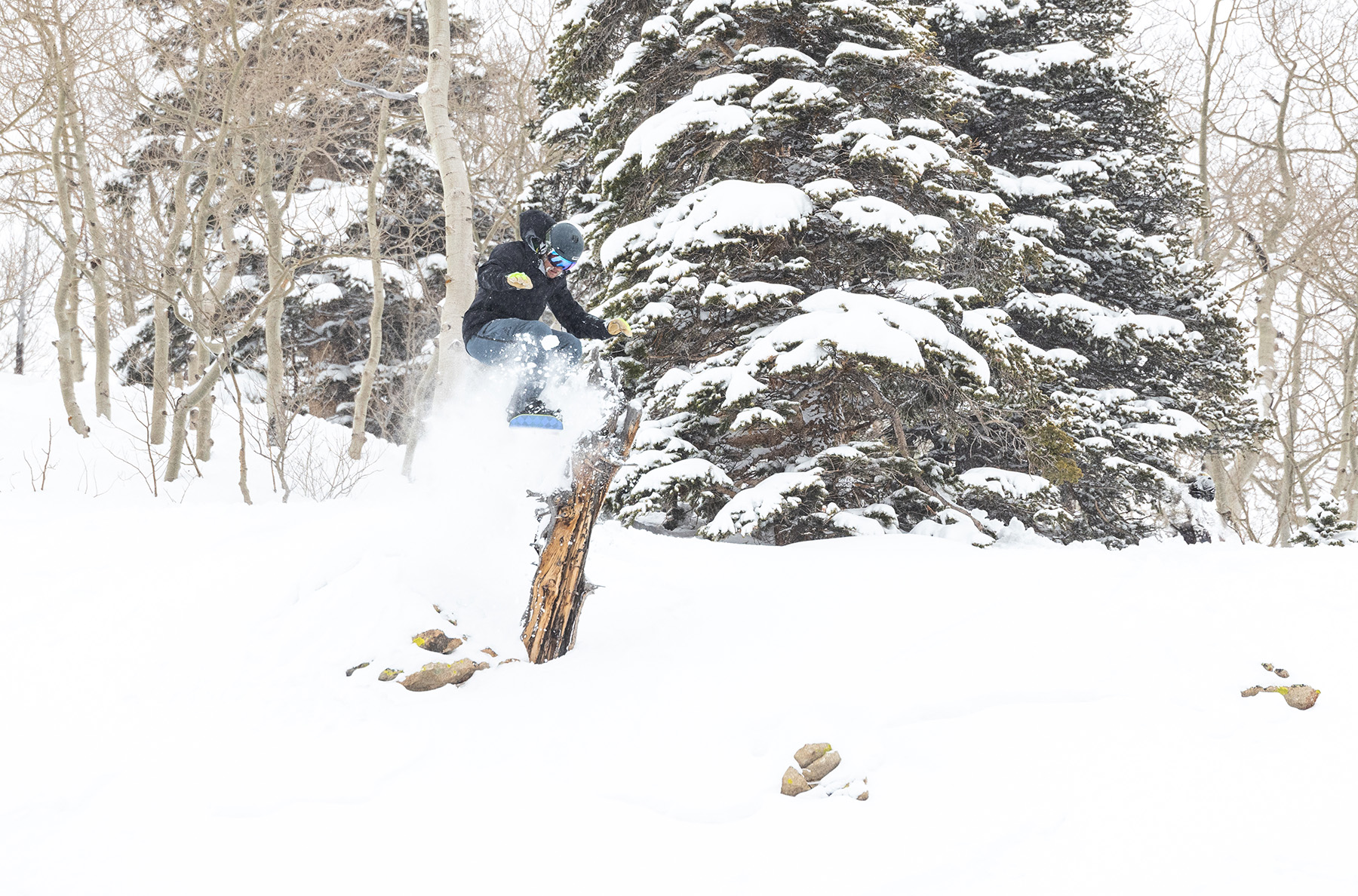

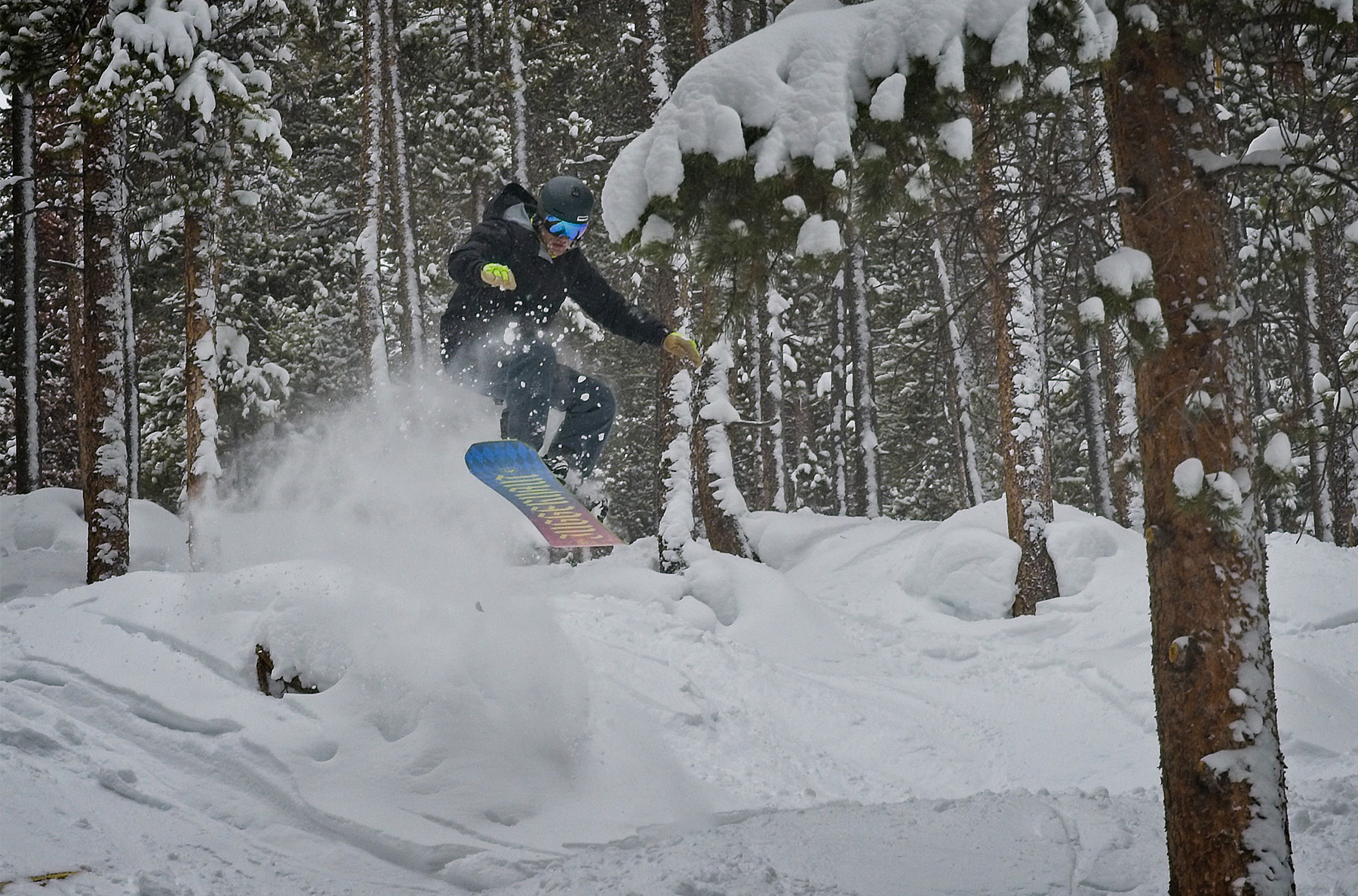
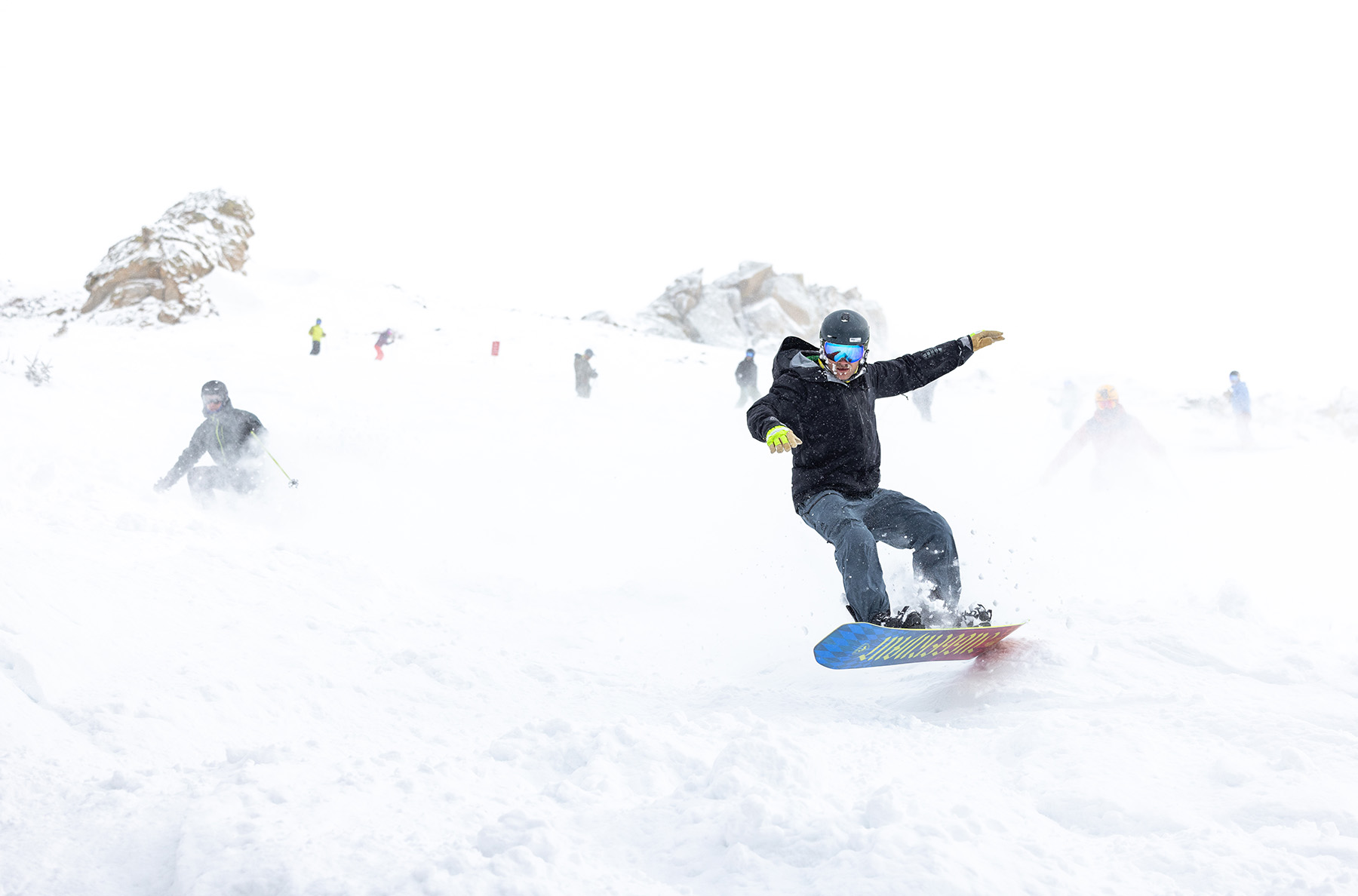
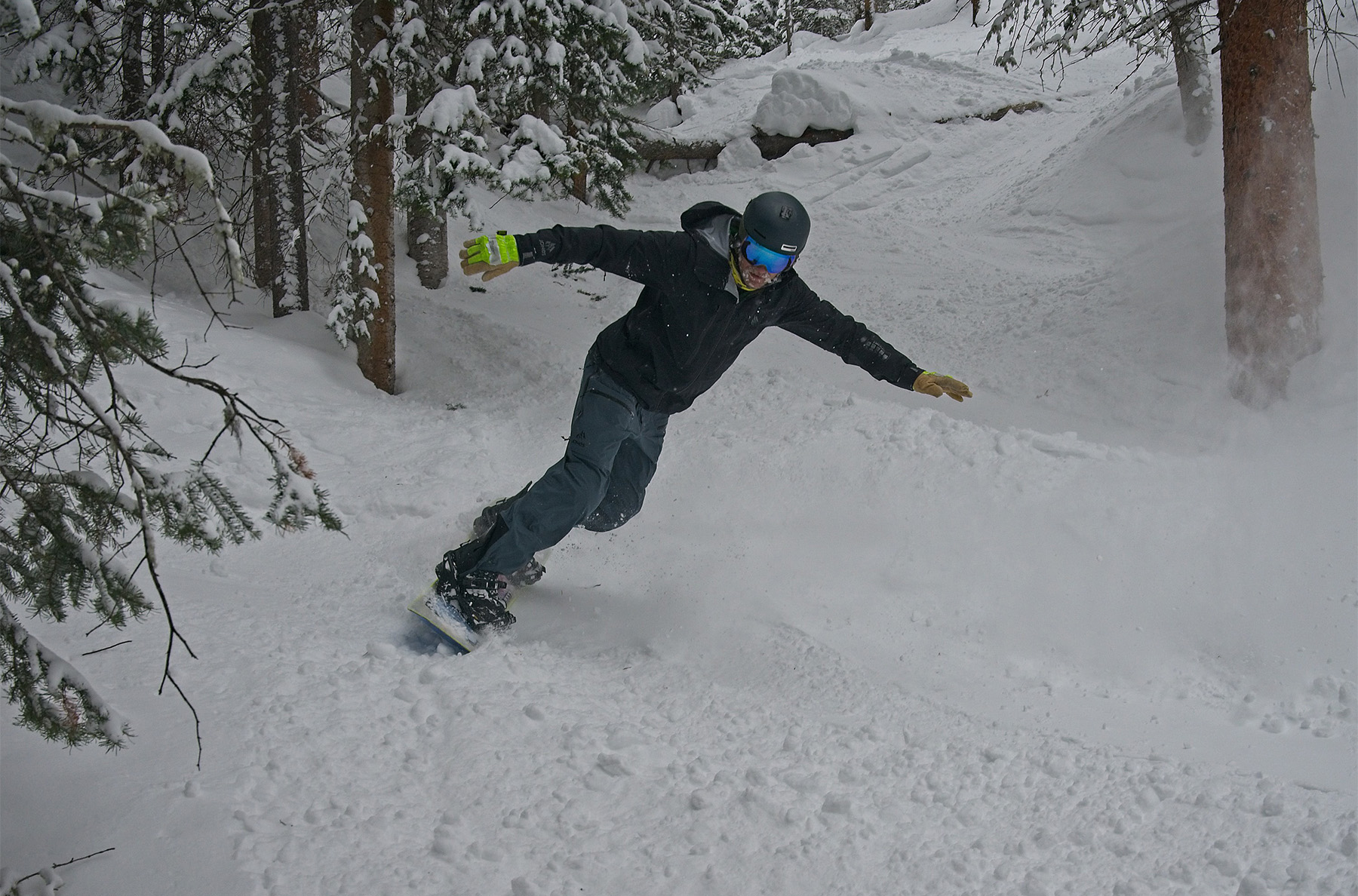
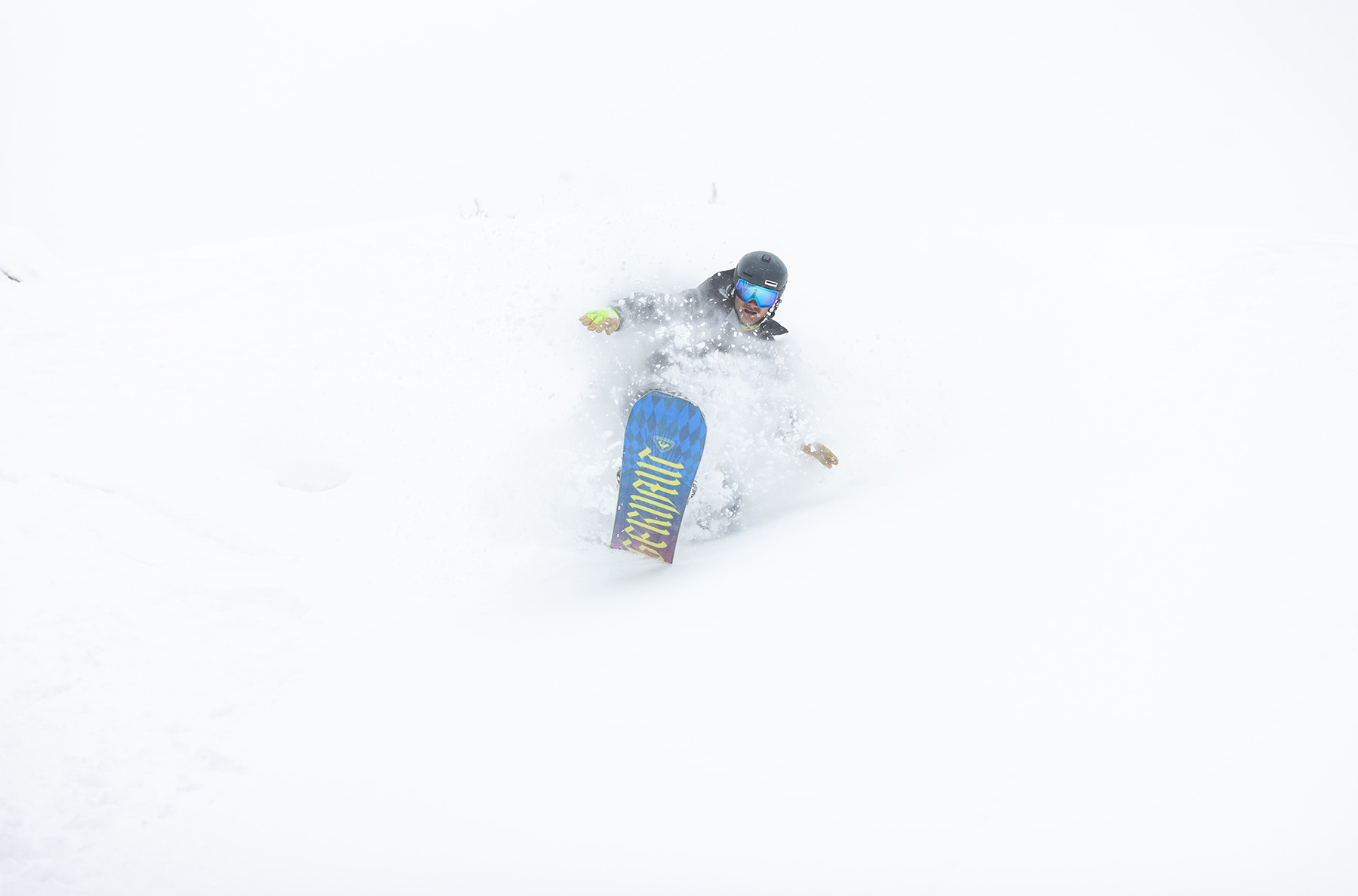

Nice detailed thorough review, thanks for all the info. I plan on getting these soon.
Thank you very much for detailed review:-)